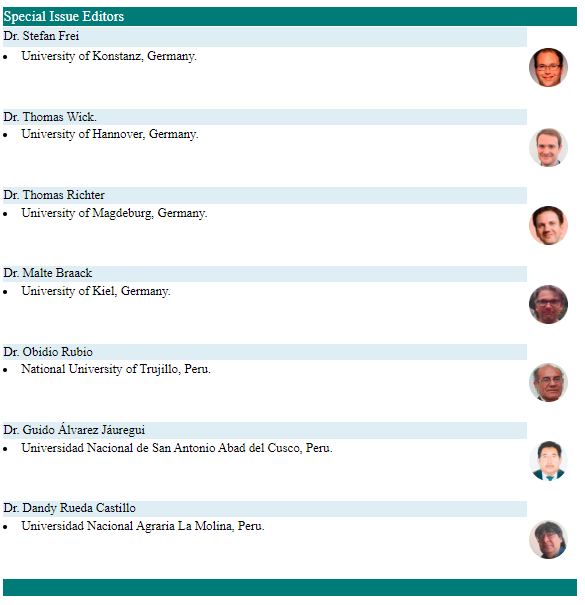Frobenius methods for analytic second order linear partial differential equations
DOI:
https://doi.org/10.17268/sel.mat.2023.02.01Palavras-chave:
Frobenius method, regular singularity, analytic solutions, partial differential equationResumo
The main subject of this text is the study of analytic second order linear partial differential equations. We aim to solve the classical equations and some more, in the real or complex analytical case. This is done by introducing methods inspired by the method of Frobenius method for second order linear ordinary differential equations. We introduce a notion of Euler type partial differential equation. To such a PDE we associate an indicial conic, which is an affine plane curve of degree two. Then comes the concept of regular singularity and finally convergence theorems, which must necessarily take into account the type of PDE (parabolic, elliptical or hyperbolic) and a nonresonance condition. This condition gives a new geometric interpretation of the original condition between the roots of the original Frobenius theorem for second order ODEs. The interpretation is something like, a certain reticulate has or not vertices on the indexical conic. Finally, we retrieve the solution of all the classical PDEs by this method (heat diffusion, wave propagation and Laplace equation), and also increase the class of those that have explicit algorithmic solution to far beyond those admitting separable variables. The last part of the text is dedicated to the construction of PDE models for the classical ODEs like Airy, Legendre, Laguerre, Hermite and Chebyshev by two different means. One model is based on the requirement that the restriction of the PDE to lines through the origin must be the classical ODE model. The second is based on the idea of having symmetries on the PDE model and imitating the ODE model. We study these PDEs and obtain their solutions, obtaining for the framework of PDEs some of the classical results, like existence of polynomial solutions (Laguerre, Hermite and Chebyshev polynomials).
Referências
Borthwick D. Introduction to Partial Differential Equations. Cham: Springer; 2016. 285 p.
Frobenius G. Ueber die Integration der linearen Differentialgleichungen durch Reihen. Journal für die Reine und Angewandte Mathematik. 1873; 76: 214–235.
Boyce WE, DiPrima RC. Elementary Differential Equations and Boundary Value Problems. 10a ed. New York: John Wiley & Sons; 2012. 672 p.
Coddington EA. An Introduction to Ordinary Differential Equations. New York: Dover Publications; 1989. 292 p.
León V, Rodriguez A, Scárdua B. Analysis of third order linear analytic differential equations with a regular singularity: Bessel and other classical equations. Annals of Mathematical Sciences and Applications. 2021; 6(1): 51–83.
Griffiths D. Introduction to Quantum Mechanics. 2a ed. New Jersey: Person Prentice Hall; 2005. 484 p.
Bethe HA, Salpeter EE. Quantum Mechanics of One- and Two-Electron Atoms. Berlin: Springer-Verlag; 1957. 369 p.
Hua LK. Introduction to Number Theory. Berlin, Heidelberg and New York: Springer-Verlag; 1982. 574 p.
León V, Scárdua B. A complete Frobenius type method for linear partial differential equations of third order. Differential Equations & Applications. 2021; 13(2): 115–149.
Matthews K. Solving the diophantine equation ax2 + bxy + cy2 + dx + ey + f = 0. Available from http://www.numbertheory.org/PDFS/general_quadratic_solution.pdf
Downloads
Publicado
Como Citar
Edição
Seção
Licença
Copyright (c) 2023 Selecciones Matemáticas

Este trabalho está licenciado sob uma licença Creative Commons Attribution 4.0 International License.
Os autores que publicam nesta revista aceitam as seguintes condições:
Os autores mantêm os direitos autorais e atribuem à revista o direito da primeira publicação, com o trabalho registrado com a licença de atribuição Creative Commons Atribución 4.0 Internacional (CC BY 4.0), que permite que terceiros usem o material publicado sempre que mencionarem a autoria do trabalho e os direitos autorais. Primeira publicação nesta revista.
Os autores podem fazer outros acordos contratuais independentes e adicionais para a distribuição não exclusiva da versão do artigo publicada nesta revista (por exemplo, incluí-la em um repositório institucional ou publicá-la em um livro), desde que afirme claramente que o trabalho Foi publicado nesta revista.
É permitido e recomendado aos autores que publiquem seus trabalhos na Internet (por exemplo, em páginas institucionais ou pessoais) antes e durante o processo de revisão e publicação, pois isso pode levar a trocas produtivas e a uma disseminação maior e mais rápida do trabalho. publicado (Consultar: efeito do acesso aberto).












